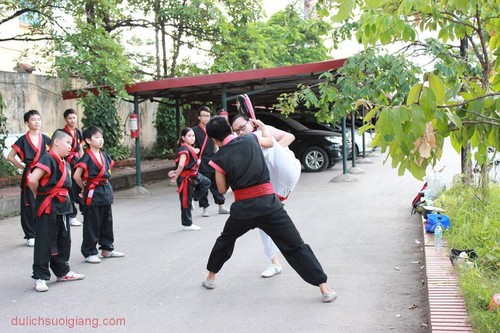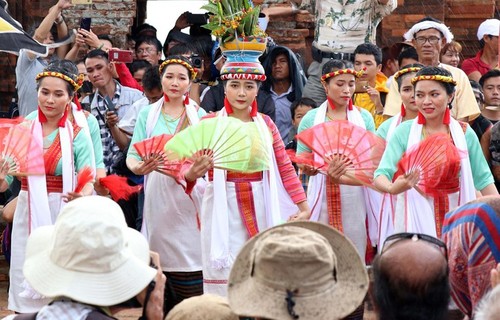A: First on our show today, we’d like to say thanks to Felix Gurevich, a VOV listener from the US who reported on the reception for our broadcast in Portugal.
B: Mr. Gurevich listened to our broadcast from 19:00 to 19:27 on August 24 on the frequency of 7280 khz. He wrote: “For the first time I tuned in to Voice of Vietnam on 7280 khz while in Portugal. The signal was weaker than when I listened to your program on 7315 khz at 02:00 UTC. For SINPO rating, I will give 34444. I really enjoyed today’s program. From the news I learned that Vietnam won 4 gold medals at the Taekwondo Pomsae World Championship. I’m very interested in martial arts. For many years, I studied the Japanese martial art of Karate. And now for about 5 years, I’ve practiced Chinese traditional martial arts – Tai chi and Chi kung. What are the traditional martial arts of Vietnam?”
 Nhat Nam martial art (Photo: dulichsuoigiang.com) Nhat Nam martial art (Photo: dulichsuoigiang.com) |
A: Vietnamese traditional martial arts has been divided into various sects through the generations, like Nhat Nam, Vovinam, and Tay Son Binh Dinh. These martial arts have played a significant role in building and defending the Vietnamese nation. Traditional martial arts have been developed in most of the provinces and cities of Vietnam. In one of the Letter Box segments in June, we informed you about Vovinam, a Vietnamese form of martial arts, which has been spreading throughout the world during the last 80 years. In today’s Letter Box, let’s check out Nhat Nam, another of the Vietnamese martial arts schools, with one of the longest histories.
B: Nhat Nam aims to cultivate both physical and emotional strength. It is deeply connected to Vietnam’s roots and the fight against northern invaders and embodies the Vietnamese principle of finding strength in apparent weaknesses.
A: The Nhat Nam martial arts school has existed in Vietnam since the thirteenth or fourteenth century. It is said that Nhat Nam is derived from a martial art called “Het” or “Hec” in present day Thanh Hoa, Nghe An, and Ha Tinh province. The name “Nhat Nam” was adopted after all the sects of Hét martial arts were consolidated.
B: Nhat Nam was designed to suit the physical characteristics of the Vietnamese. According to Master Dao Trung Hieu, Head of the Nhat Nam Yen Hoa martial arts club, Nhat Nam is specifically tailored for the Vietnamese. The essence of Nhat Nam is the principle of weakness overcoming strength and it’s the basis of all the moves and exercises. In practice, the martial artist uses evasive techniques to cause the opponent’s attack to fall short. With the opponent exposed, the Nhat Nam master strikes.
A: Nhat Nam was once popular in every village where people regularly studied Nhat Nam to train their body, perform at cultural festivals, and ultimately defend their homeland against invaders. According to practitioners of Nhat Nam, the purpose of martial arts is to train the mind as well as the body. The ultimate goal is to instill moral principles. Nhat Nam masters teach their students the importance of morality and moderation.
B: To preserve and promote this form of martial arts as an intangible cultural heritage, many free classes have been opened around Hanoi, drawing a large number of young martial artists.
B: On today’s program, we’d like to welcome Michael Downs from Knoxville, Tennessee, in the US. Mr. Downs listened to our broadcast on September 4 on the frequency of 7315 khz and reported the reception was quite good, with some fading by the end of the program.
A: Thank you, Mr. Downs, for tuning in to our broadcast. We’ll send you a QSL card to confirm your report. Our program is now also available on the internet at vovworld.vn or vov5.vn. You can also listen to our broadcast on the mobile app, “VOV media”. We look forward to more regular reports from you.
B: This week, many listeners in Bangladesh and Pakistan asked us about festivals in Vietnam. It’s such a rich topic, there’s not enough time to tell you about all the festivals in just one show, because there are so many held around Vietnam throughout the year.
A: For today, let’s check out one of the most recent festivals, the Kate Festival, also called Mbang Kate, of the Cham people which is held for 3 days at the beginning of October. This event takes place in a large space in the three Champa Towers known as Po Nagar, Po Klong Garai and Po Rome. The main purpose of the festival is to commemorate their heroes, like Po Klong Garai and Po Rome, and also remember family members who passed away. Also, the festival is a chance for the local people to relax, gather and wish one another good fortune for the future.
 Cham Brahman women dance in the Kate festinal at Po Klong Garai tower. (photo: VNA) Cham Brahman women dance in the Kate festinal at Po Klong Garai tower. (photo: VNA) |
B: This is one of the biggest and most important events of the Cham people in Vietnam. Therefore, it is a special opportunity for visitors to experience the richness of the Cham culture, from architecture to costumes, instruments and traditional songs that are used to praise their kings of the past. The Kate festival starts all the three towers simultaneously and the following day, families hold their own rites.
A: During the rites, the people call on their ancestors and gods with the help of a shaman, and then pray for health and prosperity. The festivals take place after the rites, in a combination of traditional music and dance, including performances of Ginang Drums the Saranai Flute or the traditional dances of Cham girls.
B: The Kate Festival is recognised as an intangible cultural heritage by the Ministry of Culture, Sports and Tourism. It is one of the 15 biggest festivals in Vietnam, attracting thousands of domestic and international visitors every year.
A: This week, we’d like to welcome back Hannu Tikkanen of Finland to VOV. In an email to VOV this week, he wrote: “It’s a great pleasure to inform you that your AM station signals were picked up on the other side of the world! This was a genuine reception with a radio receiver and an outdoor aerial, not via internet. I’m an old timer radio enthusiast who likes to listen to the radio with all the noise and interference, instead of choosing a streaming channel from stations’ websites. Though I’ve been listening to distant radio stations for over 46 years as my primary hobby, it’s still a thrilling experience to hear stations on the radio. The first time I heard Voice of Vietnam was in 1974 on short wave, and I have the QSL-card in my collection from that time. Thank you very much for the programming.”
B: Thank you, Mr. Tikkanen, for coming back and for your detailed reception report. We’ll confirm your report with a QSL card and we look forward to more feedback from you.
A: We’d like to confirm reception reports from other listeners including Tarek, Saif Khan, and Miss Maria of Bangladesh, Siddhartha Bhattacharjee and Shyamal Kumar Banerjee of India, Umar Qvick of Sweden, and Eddy Prabowo of Indonesia.
B: We’d like to thank you all for sending feedback on our shortwave broadcasts and internet content. We’ll send you verification cards to confirm your reports.
A: We welcome your feedback at: English Service, VOVworld, the Voice of Vietnam, 45 Ba Trieu street, Hanoi, Vietnam. Or you can email us at englishsection@vov.org.vn. You’re invited to visit us online at vovworld.vn, where you can hear both live and recorded programs. Check out our VOV Media App available on both the IOS and Android platform to hear our live broadcasts. We look forward to your comments and suggestions. Once again, thank you all for listening. Goodbye until next time.